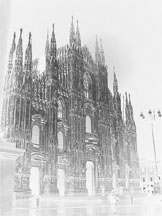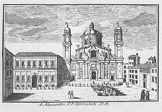The "bride’s church", Renaissance courtyards and squares between tortuous paths and unexpected wide open spaces
Winding paths leads to Renaissance courtyards and squares, underlining once more the infinite attractions of the surprising city of Milan ... such as the "bride’s church".
Church of Saint Alessandro in Zebedia
The church was built in 1601 on a project by Lorenzo Birago and helped, as expert in static instabilities, by the famous Francesco Maria Richini; the church rose on Sant’Alessandro square where the tradition wants that Martyr Sant’Alessandro was imprisoned.
The central plan is a Greek cross surmounted by a dome and a minor area with the presbytery; this is one of the last examples of this kind of planimetry, the same one used by Bramante for San Pietro in Rome.
This church presents some difference from the classic Bramante’s project such as the façade, which is decorated with bas-relief and presents two bell towers with curved fastigium; this kind of style gave a horizontal visual impact more evident than in other Renaissance building.
Palazzo Trivulzio - Trivulzio’s Palace
Originally this palace was a small castle built in the second century and at the end of V century became propriety of the Trivulzio family.
During the following centuries new parts were added or renewed; the tower was transformed from prison to residential area.
The façade is composed by an ancient doors surrounded by an arch and surmounted by a balcony. This palace once has hosted the Library and the Trivulzio’s Collection afterwards moved to the Sforzesco Castle where nowadays is hosted.
Palazzo Recalcati - Recalcati’s Palace
This palace is characterized by a sixteenth century colonnade; the columns have terracotta arched lintel and are surmounted by arcades.
Scuole Arcimbolde - Arcimbolde Schools
In 1603 the very devout man Giuseppe Arcimboldi left a lot of money and real estates to the order of Barnabite Fathers, to use it for the education of poor people. The schools were built near the church of Sant’Alessandro in San Giovanni in Conca Square; from the very beginning private schools (1601) was inaugurated as a public schools, as per Arcimboldi’s wishes, in 1609 with a solemn ceremony presided by bishop Federico Borromeo.
Church of Santa Eufemia
Founded between 472 and 475 by Archbishop San Senatore Settala the church was rebuilt in the XV century and modified several times during the following millennium.
The nowadays building is the result of the last restoration made by architect Enrico Terzaghi in 1870. Few years later was restored the façade using stones and terracotta; afterwards was built the three arch colonnade with mosaics that reproduces the Luigi Cavenaghi frescoes.
Inside there are beautiful sixteenth century wooden panel paintings like the "Wedding of Santa Caterina" situated in the first chapel of the left side and probably realized by Marco Oggiono a pupil of the Leonardo’s school. On the second of the left side chapel there is a painting by Bernardino Bergognone and on the third the painting representing Madonna and Child in between Saints and musicians Angels. The fresco of the triumphal arch was made by Luigi Cavenaghi , the one in the basin’s apse it is a work of Agostino Caironi.
Church of Santa Maria in San Celso
The church was built in 1493 by Gian Giacomo Dolcebuono and Giovanni Battagio to host a miraculous icon of Our Lady; first was built the octagonal dome and the arcade adorned with 12 terracotta statues made by Agostino De Fondulis.
In 1506 was added a nave and two side aisles, the central one was completed with a majestic lacunar barrel vault built by Giovanni Antonio Amadeo; the presbytery was enriched with a polygonal imitating the Dome of Milan model.
At the beginning of the XVI century was added the four ways colonnade in attempt to copying the ancient Roman style; Galeazzo Alessi at the end of the same century projected a very imposing and richly adorned façade.
The façade was built afterwards by Martino Bassi using a simplified version of the Alessi’s project; it was built with Carrara marble and decorated with several statues and reliefs by Stoldo Lorenzi and Annibale Fontana.
|















